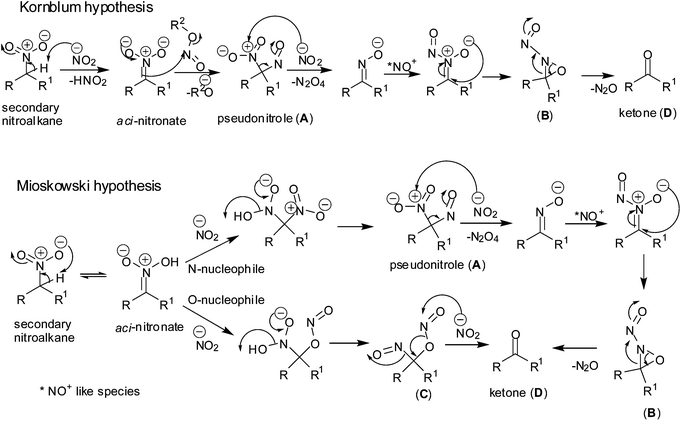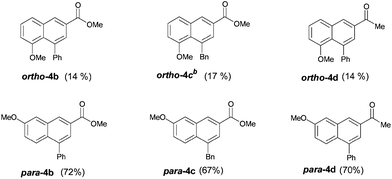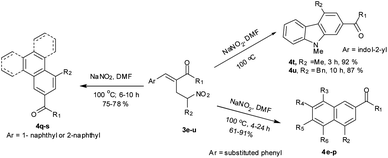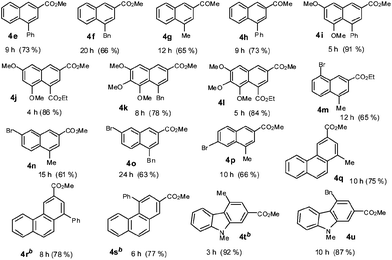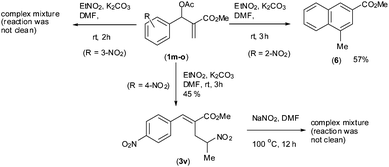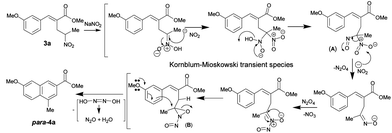The Baylis–Hillman acetates in organic synthesis: Unprecedented sodium nitrite induced intramolecular Friedel–Crafts cyclization of secondary nitro compounds†
Deevi Basavaiah* and
Daggula Mallikarjuna Reddy
School of Chemistry, University of Hyderabad, Hyderabad-500 046, India. E-mail: dbsc@uohyd.ernet.in; Fax: +91-40-23012460
First published on 19th May 2014
Abstract
Unprecedented sodium nitrite mediated intramolecular Friedel–Crafts cyclization of alkyl (E)-2-arylidene-4-nitroalkanoates and (E)-3-arylidene-5-nitroalkan-2-ones derived from Baylis–Hillman acetates, providing a facile protocol for synthesis of naphthalenes, phenanthrenes, and carbazoles has been described.
The nitro group is one of the key functional groups that plays a vital role in synthetic chemistry.1 The high electron withdrawing ability of the nitro group has resulted in numerous applications of nitroalkanes as carbon nucleophiles in various carbon–carbon bond forming reactions.2 The Nef reaction is yet another useful reaction which transforms the nitro group into the carbonyl group.3 It is very interesting to note the work of Kornblum who, as early as in 1956, reported an elegant conversion of aliphatic nitro compounds into ketones via the reaction with alkyl nitrite and sodium nitrite. The reaction is believed to proceed via nitrosation of aci-nitronate.4 Four decades later in 1997 Mioskowski has reported an interesting sodium nitrite mediated nitrosation of primary nitroalkanes leading to the formation of carboxylic acids.5a In 2004 the research group of Mioskowski also described facile conversion of secondary nitroalkanes into ketones using sodium nitrite under neutral conditions (Scheme 1).5b
It needs to be mentioned here that there are a few reports in the literature on the application of aliphatic nitro compounds as electrophiles in the Friedel–Crafts (F–C) reaction in the presence of various acids.6 Kim and co-workers reported sulphuric acid mediated intramolecular F–C reaction of the aliphatic nitro compounds obtained from the Baylis–Hillman (BH) adducts producing naphthalene derivatives.6d
Although the in situ generated transient (Kornblum–Mioskowski) species A, B and C in Scheme 1, look potential electrophiles for F–C reaction, to the best of our knowledge, there have been, so far, no such reports in the literature. Therefore we envisioned that secondary nitro-alkanes (3) obtained from the BH acetates (1) would be excellent synthons for intramolecular F–C cyclization using NaNO2 as reagent to provide a simple protocol for obtaining naphthalenes (4a–p), phenanthrenes (4q–s) and carbazoles (4t, 4u) as shown in the retro synthetic strategy (Scheme 2). Accordingly, in continuation of ongoing research program7 on the BH reaction8,9 we examined these reactions and were pleased to see NaNO2 mediated intra-molecular F–C cyclization of secondary nitroalkanes (3) work reasonably well. These results are reported in this communication.
We began our investigations with methyl (E)-2-(3-methoxy-benzylidene)-4-nitropentanoate (3a, R1 = OMe, R2 = Me, Ar = 3-MeOC6H4) which was easily obtained via alkylation of nitroethane 2a with the BH-acetate, methyl 3-acetoxy-3-(3-methoxyphenyl)-2-methylenepropanoate (1a, R1 = OMe, Ar = 3-MeOC6H4).
 | (1) |
We performed the reaction between methyl (E)-2-(3-methoxybenzylidene)-4-nitropentanoate (3a) (1 mmol) with sodium nitrite in the presence of various solvents and at different reaction conditions (entries 1–14, Table 1). In this direction, best results were obtained when a solution of 3a (1 mmol) and NaNO2 (1 mmol) in DMF (4 mL) was heated at 100 °C for 8 h, thus providing methyl 5-methoxy-4-methylnaphthalene-2-carboxylate (ortho-4a) (ortho cyclized product) and methyl 7-methoxy-4-methylnaphthalene-2-carboxylate (para-4a) (para cyclized product) in 13% and 71% isolated yields respectively (Table 1, entry 11) after usual work up, followed by purification through silica gel column chromatography.10
| Entry | NaNO2 (eq.) | Solvent | Temp/°C | Time/h | Yieldb (%) o-4a/p-4a |
|---|---|---|---|---|---|
a All reactions were carried out on 1 mmol scale of 3a in 4 mL of solvent.b Isolated yields based on 3a.c DMSO–H2O (3.5![[thin space (1/6-em)]](https://www.rsc.org/images/entities/char_2009.gif) : :![[thin space (1/6-em)]](https://www.rsc.org/images/entities/char_2009.gif) 0.5 mL). 0.5 mL). |
|||||
| 1 | 1.0 | DMSO–H2Oc | 60 | 20 | 16/65 |
| 2 | 1.0 | DMSO | 60 | 20 | 14/68 |
| 3 | 1.0 | DMF | RT | 24 | N.R |
| 4 | 1.0 | DMF | 40 | 24 | N.R |
| 5 | 1.0 | DMF | 60 | 20 | 11/67 |
| 6 | 1.0 | DMF | 80 | 15 | 12/71 |
| 7 | 1.0 | EtOH | 78 | 24 | N.R |
| 8 | 1.0 | 1,4-dioxane | 100 | 24 | N.R |
| 9 | 1.0 | Water | 100 | 24 | N.R |
| 10 | 1.0 | DMSO | 100 | 8 | 12/69 |
| 11 | 1.0 | DMF | 100 | 8 | 13/71 |
| 12 | 1.0 | DMF | 120 | 8 | 8/40 |
| 13 | 0.5 | DMF | 100 | 8 | 8/48 |
| 14 | 2.0 | DMF | 100 | 8 | 10/70 |
With a view to further understand this strategy we have subjected the nitro compounds (3b and 3c) [prepared from the BH acetate (1a) and nitroalkanes (2b and 2c) (R2 = Ph, Bn)] to the reaction with NaNO2 which provided the required substituted naphthalenes 4b and 4c in overall 86 and 84% yields respectively [see Table 2 for composition of para (major) and ortho (minor) cyclized products]. We have also examined the F–C cyclization of the nitro compound (3d, R1 = Me, R2 = Ph, Ar = 3-MeOC6H4) with NaNO2 which gave the desired naphthalene, para-4d in 70% yield along with ortho-4d in 14% yield (Table 2).
With a view to understand the generality of this reaction we have prepared representative arylidene secondary nitroalkane compounds (3e–u) (eqn (1)) and subjected them to Friedel–Crafts cyclization reaction under the influence of NaNO2. The resulting naphthalene (4e–p), phenanthrene (4q–s) and carbazole (4t and 4u) derivatives were obtained in good to excellent yields as shown in Table 3.
With a view to understand the role of electron withdrawing group on aryl system in the F–C cyclization we have selected methyl 3-acetoxy-3-(2-nitrophenyl)-2-methylenepropanoate (1m) as a substrate for reaction with nitroethane (2a) in the presence of K2CO3 in DMF. In this case we did not observe formation of any arylidene secondary nitroalkane compound, but we have directly obtained methyl 4-methylnaphthalene-2-carboxylate (6) in 57% yield (Scheme 3). It should be mentioned here that a similar reaction is already reported by Horn and Perez.11 We have examined alkylation of methyl 3-acetoxy-3-(3-nitrophenyl)-2-methylenepropanoate (1n) with nitroethane (2a) in the presence of K2CO3 and found that this reaction was not clean (Scheme 3). However alkylation of methyl 3-acetoxy-3-(4-nitrophenyl)-2-methylenepropanoate (1o) with nitroethane (2a) in the presence of K2CO3 provided the desired nitroarylidene secondary nitroalkane derivative (3v) in 45% yield. But, our attempts for intramolecular F–C reaction of 3v with NaNO2 under similar conditions were not successful (Scheme 3).
Next we have studied the role of acids12 (both Lewis and Brønsted) as additives on the NaNO2 mediated F–C reaction of 3a. Since similar F–C reactions of arylidene secondary nitro compounds using conc. H2SO4 is already known in the literature6d we did not use strong acids in our studies.12 We have examined the applications of AlCl3 and AcOH as additives in our studies (Table 4). From these studies it is clear that AcOH–DMF at 100 °C accelerates the rate of reaction to a reasonable extent (entry 8: Table 4) providing slightly inferior yields in comparison to our earlier result (entry 11: Table 1). The rate acceleration might be attributed to the possible stabilization of aci-nitronate with acid as mentioned in Scheme 1.
| Entry | Additive | Solvent | Temp/°C | Time/h | Yieldb (%) o-4a/p-4a |
|---|---|---|---|---|---|
| a All reactions were carried out on 1 mmol scale of 3a in 4 mL of solvent.b Isolated yields based on 3a. | |||||
| 1 | AlCl3 | DCE | RT | 24 | N.R |
| 2 | AlCl3 | DCE | 80 | 12 | N.R |
| 3 | AlCl3 | DMF | RT | 24 | N.R |
| 4 | AlCl3 | DMF | 100 | 12 | Trace |
| 5 | AcOH | DCE | RT | 24 | N.R |
| 6 | AcOH (excess) | RT | 24 | N.R | |
| 7 | AcOH | DMF | RT | 24 | 5/21 |
| 8 | AcOH | DMF | 100 | 4 | 14/66 |
A plausible mechanism for NaNO2 mediated intramolecular F–C reaction is illustrated in Scheme 4 taking the nitro compound 3a as a model case and assuming that transient species oxaziridine (B) as the reactive electrophile. However we cannot rule out the involvement of any other similar reactive electrophiles. In fact, we have also considered the possibility of generation of in situ ketone (D as in Scheme 1) which might cyclize in the presence of NaNO2. Even though we are not sure of such possibility, with a view to confirm our understanding we made the ketone13 [methyl (E)-2-(3-methoxybenzylidene)-4-oxopentanoate (5a)] via Nef reaction of 3a which then was treated with NaNO2 in DMF at 100 °C for longer times (upto 20 h). We did not notice formation of any Friedel–Crafts product. This result unequivocally confirms that the ketone (5a) is not the key intermediate and further confirms that the electrophile is the Kornblum–Mioskowski transient oxaziridine species (B) or related transient such as A or C as shown in Scheme 1. It is believed that the formation of heterocyclic compound (4t) from 3t follows a similar mechanism as in the formation of 4a from 3a as described in Scheme 4.
It should be mentioned here the importance of polycyclic aromatic compounds, especially substituted naphthalenes, phenanthrenes and carbazoles as these structural frameworks are present in several biologically active molecules14 and natural products.14d,15 Also these compounds are extensively used as building blocks for the synthesis of biologically active molecules14 and polycyclic aromatic materials.16 Therefore, development of facile strategies for obtaining these molecules has been and continues to be a challenging endeavor in synthetic chemistry.17,9j,18 The present methodology indeed constitutes another important strategy for obtaining these structurally important frameworks using NaNO2 as a mild reagent.
In summary, we have, for the first time, described novel sodium nitrite mediated intramolecular Friedel–Crafts alkylation of secondary nitroalkanes derived from Baylis–Hillman adducts under neutral conditions. This reaction provides a facile methodology for the synthesis of naphthalene, phenanthrene and carbazole derivatives that are of tremendous importance in medicinal and material chemistry. Since this methodology describes the Friedel–Crafts reaction under neutral conditions we believe this protocol will find extensive applications in synthetic chemistry.
Acknowledgements
We thank the DST (New Delhi) for funding this project. DMR thanks CSIR and DST (New Delhi) for his research fellowships. We thank the UGC (New Delhi) for support and providing some instrumental facilities. We are grateful to the National Single-Crystal X-ray and HRMS facilities funded by the DST. We also thank Professor S. Pal, School of Chemistry, and University of Hyderabad for helpful discussions regarding X-ray data analysis.Notes and references
- (a) J. P. Adams and J. R. Paterson, Perkin 1 (2000), 2000, 3695 RSC; (b) J. P. Adams, J. Chem. Soc., Perkin Trans. 1, 2002, 2586 RSC.
- (a) F. A. Luzzio, Tetrahedron, 2001, 57, 915 CrossRef CAS; (b) R. Ballini, A. Palmieri and L. Barboni, Chem. Commun., 2008, 2975 RSC; (c) R. Ballini and M. Petrini, ARKIVOC, 2009, 195 CAS.
- R. Ballini and M. Petrini, Tetrahedron, 2004, 60, 1017 CrossRef CAS PubMed.
- N. Kornblum, R. K. Blackwood and D. D. Mooberry, J. Am. Chem. Soc., 1956, 78, 1501 CrossRef CAS.
- (a) C. Matt, A. Wagner and C. Mioskowski, J. Org. Chem., 1997, 62, 234 CrossRef CAS; (b) A. Gissot, S. N’Gouela, C. Matt, A. Wagner and C. Mioskowski, J. Org. Chem., 2004, 69, 8997 CrossRef CAS PubMed.
- (a) V. Bonvino, G. Casini, M. Ferappi, G. M. Cingolani and B. R. Pietroni, Tetrahedron, 1981, 37, 615 CrossRef CAS; (b) G. Casini, M. Ferappi, G. M. Cingolani and B. R. Pietroni, La Chimica e l'Industria, 1974, 56, 463 Search PubMed; (c) N. Ono, T. Yanai, A. Kamimura and A. Kaji, J. Chem. Soc., Chem. Commun., 1986, 1285 RSC; (d) K. Y. Lee, S. Gowrisankar, Y. J. Lee and J. N. Kim, Tetrahedron, 2006, 62, 8798 CrossRef CAS PubMed.
- (a) D. Basavaiah, B. S. Reddy and H. Lingam, Tetrahedron, 2013, 69, 1994 CrossRef CAS PubMed; (b) D. Basavaiah, S. S. Badsara and B. C. Sahu, Chem. – Eur. J., 2013, 19, 2961 CrossRef CAS PubMed; (c) D. Basavaiah, K. S. Kumar, K. Aravindu and B. Lingaiah, RSC Adv., 2013, 3, 9629 RSC; (d) D. Basavaiah and D. M. Reddy, Org. Biomol. Chem., 2012, 10, 8774 RSC; (e) D. Basavaiah and D. V. Lenin, Eur. J. Org. Chem., 2010, 5650 CrossRef CAS; (f) D. Basavaiah and R. J. Reddy, Org. Biomol. Chem., 2008, 6, 1034 RSC; (g) D. Basavaiah and T. Satyanarayana, Chem. Commun., 2004, 32 RSC; (h) D. Basavaiah, D. S. Sharada and A. Veerendhar, Tetrahedron Lett., 2004, 45, 3081 CrossRef CAS PubMed; (i) D. Basavaiah and R. M. Reddy, Tetrahedron Lett., 2001, 42, 3025 CrossRef CAS; (j) D. Basavaiah, M. Bakthadoss and S. Pandiaraju, Chem. Commun., 1998, 1639 RSC.
- For recent reviews on BH reaction see: (a) Y. Wei and M. Shi, Chem. Rev., 2013, 113, 6659 CrossRef CAS PubMed; (b) D. Basavaiah and B. C. Sahu, Chimia, 2013, 67, 8 CrossRef CAS PubMed; (c) T.-Y. Liu, M. Xie and Y.-C. Chen, Chem. Soc. Rev., 2012, 41, 4101 RSC; (d) D. Basavaiah and G. Veeraraghavaiah, Chem. Soc. Rev., 2012, 41, 68 RSC; (e) D. Basavaiah, B. S. Reddy and S. S. Badsara, Chem. Rev., 2010, 110, 5447 CrossRef CAS PubMed; (f) V. Declerck, J. Martinez and F. Lamaty, Chem. Rev., 2009, 109, 1 CrossRef CAS PubMed; (g) V. Singh and S. Batra, Tetrahedron, 2008, 64, 4511 CrossRef CAS PubMed; (h) G. Masson, C. Housseman and J. Zhu, Angew. Chem., Int. Ed., 2007, 46, 4614 CrossRef CAS PubMed; (i) D. Basavaiah, A. J. Rao and T. Satyanarayana, Chem. Rev., 2003, 103, 811 CrossRef CAS PubMed.
- For recent papers on BH reactions see: (a) F.-L. Hu, Y. Wei, M. Shi, S. Pindi and G. Li, Org. Biomol. Chem., 2013, 11, 1921 RSC; (b) D. Basavaiah, B. S. Reddy and H. Lingam, Tetrahedron, 2013, 69, 10060 CrossRef CAS PubMed; (c) J. T. M. Correia, M. T. Rodrigues, Jr, H. Santos, C. F. Tormena and F. Coelho, Tetrahedron, 2013, 69, 826 CrossRef CAS PubMed; (d) T. Kumar, S. M. Mobin and I. N. N. Namboothiri, Tetrahedron, 2013, 69, 4964 CrossRef CAS PubMed; (e) Y. Yao, J.-L. Li, Q.-Q. Zhou, L. Dong and Y.-C. Chen, Chem. – Eur. J., 2013, 19, 9447 CrossRef CAS PubMed; (f) H. Zhu, N. Shao, T. Chen and H. Zou, Chem. Commun., 2013, 49, 7738 RSC; (g) Y.-L. Yang, Y. Wei and M. Shi, Org. Biomol. Chem., 2012, 10, 7429 RSC; (h) M. E. Krafft, M. J. Campbell, S. Kerrigan and J. W. Cran, Tetrahedron Lett., 2011, 52, 1090 CrossRef CAS PubMed; (i) H.-H. Kuan, R. J. Reddy and K. Chen, Tetrahedron, 2010, 66, 9875 CrossRef CAS PubMed; (j) S. H. Kim, S. Lee, H. S. Lee and J. N. Kim, Tetrahedron Lett., 2010, 51, 6305 CrossRef CAS PubMed.
- As suggested by one of the referees, we have also performed the reaction with NaNO3 instead of NaNO2. In this case (using NaNO3) we did not notice formation of any F–C product and compound 3a was intact. We thank this referee for the suggestion.
- C. R. Horn and M. Perez, Synlett, 2005, 1480 CAS.
- As suggested by one of the referee, we have examined the role of acid additives in the F–C reactions. We thank this referee for the suggestion.
- We prepared methyl (E)-2-(3-methoxybenzylidene)-4-oxopentanoate (5a) from 3a via the Nef reaction following the literature procedure (a) A. Chamakh, M. M'hirsi, J. Villieras, J. Lebreton and H. Amri, Synthesis, 2000, 295 CrossRef CAS PubMed; (b) J. M. Kim, Y. J. Im, T. H. Kim and J. N. Kim, Bull. Korean Chem. Soc., 2002, 23, 657 CrossRef CAS.
- (a) T. Ukita, Y. Nakamura, A. Kubo, Y. Yamamoto, M. Takahashi, J. Kotera and T. Ikeo, J. Med. Chem., 1999, 42, 1293 CrossRef CAS PubMed; (b) D. V. K. Murty, M. Kruseman-Aretz, S. Rouhafza-Fard, C. J. Bedord, J. M. Young, G. Jones and M. Venuti, Neuropharmacology, 1985, 44, 886 Search PubMed; (c) W. T. Colwell, V. Brown, P. Christie, J. Lange, C. Reece, K. Yamamoto and D. W. Henry, J. Med. Chem., 1972, 15, 771 CrossRef CAS; (d) H.-J. Knolker and K. R. Reddy, Chem. Rev., 2002, 102, 4303 CrossRef PubMed.
- (a) J. Ren, F. Zhang, X. Liu, L. Li, G. Liu, X. Liu and Y. Che, Org. Lett., 2012, 14, 6226 CrossRef CAS PubMed; (b) K. Krohn, S. F. Kouam, S. Cludius-Brandt, S. Draeger and B. Schulz, Eur. J. Org. Chem., 2008, 3615 CrossRef CAS; (c) M. Gondo, N. Tanaka, T. Tanaka, K. Shimomura, F. Nakanishi and K. Ishimaru, Phytochemistry, 1999, 51, 879 CrossRef CAS; (d) T.-S. Wu, L.-F. Ou and C.-M. Teng, Phytochemistry, 1994, 36, 1063 CrossRef CAS.
- (a) K. M. Omer, S.-Y. Ku, Y.-C. Chen, K.-T. Wong and A. J. Bard, J. Am. Chem. Soc., 2010, 132, 10944 CrossRef CAS PubMed; (b) A. M. Machado, M. Munaro, T. D. Martins, L. Y. A. Davila, R. Giro, M. J. Caldas, T. D. Z. Atvars and L. C. Akcelrud, Macromolecules, 2006, 39, 3398 CrossRef CAS; (c) J. E. Anthony, Angew. Chem., Int. Ed., 2008, 47, 452 CrossRef CAS PubMed.
- For recent synthesis of naphthalenes, see: (a) R. S. Reddy, P. K. Prasad, B. B. Ahuja and A. Sudalai, J. Org. Chem., 2013, 78, 5045 CrossRef CAS PubMed; (b) C. C. Malakar, K. Sudheendran, H.-G. Imrich, S. Mika and U. Beifuss, Org. Biomol. Chem., 2012, 10, 3899 RSC; (c) C. Feng and T.-P. Loh, J. Am. Chem. Soc., 2010, 132, 17710 CrossRef CAS PubMed; (d) R. Balamurugan and V. Gudla, Org. Lett., 2009, 11, 3116 CrossRef CAS PubMed.
- For recent synthesis of phenanthrenes and carbazoles see: (a) L. Nassar-Hardy, C. Deraedt, E. Fouquet and F.-X. Felpin, Eur. J. Org. Chem., 2011, 4616 CrossRef CAS; (b) K. Wang, M. Lu, A. Yu, X. Zhu and Q. Wang, J. Org. Chem., 2009, 74, 935 CrossRef CAS PubMed; (c) A. W. Freeman, M. Urvoy and M. E. Criswell, J. Org. Chem., 2005, 70, 5014 CrossRef CAS PubMed; (d) J. Zhao and R. C. Larock, Org. Lett., 2005, 7, 701 CrossRef CAS PubMed.
Footnote |
| † Electronic supplementary information (ESI) available: Representative experimental procedure with spectral data of 3a–v, 4a–u, 5a, 6 and 1H and 13C NMR spectra of 4a–u and 6, crystal data (CCDC 982203, 982204, 982657 and 982658) and ORTEP diagrams of ortho-4c, 4r–t. See DOI: 10.1039/c4ra03573a |
| This journal is © The Royal Society of Chemistry 2014 |

